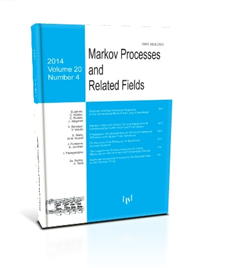An Exclusion Process with Two Types of Particles and the Hydrodynamic Limit
V. Sidoravicius, D. Surgailis, M.E. Vares
1998, v.4, Issue 2, 131-174
ABSTRACT
An exclusion model on the torus ${\ T}_N = \{1,..., N\}$ with two types of particles, $\eta $ and $\xi $, is introduced. At each site $x\in {\ T}_N$, there is at most one particle of any type, and particles of different type alternate (so that the total number of particles is even). Particles jump to neighbouring empty sites with correponding rates $ \lambda_+, \lambda_- \ge 0$ in case of $\eta$-particle, and $\mu_+, \mu_- \ge 0$ in case of $\xi$-particle. Any configuration $(\eta, \xi )$ can be represented by a $\{0, 1\}$-valued function $W = (W(x): x\in {\ T}_N)$ so that $\eta$-particle at $x\in {\ T}_N$ corresponds to the jump $ W(x-1)= 0 \to 1 = W(x)$ and $\xi$-particle at $x\in {\ T}_N$ corresponds to the jump $ W(x-1)= 1 \to 0 = W(x)$. The model admits a 1-parameter family of invariant measures, each of which, in terms of the isomorphism $(\eta, \xi) \leftrightarrow W$, is a homogeneous $\{0,1\}$-valued Markov chain on ${\ T}_N$ whose transition probabilities $p(i,j), i,j=0,1$ satisfy the equation $(\mu_+ + \lambda_-) p(0,0) = (\mu_- + \lambda_+) p(1,1)$. The main result of the paper is the derivation of the hydrodynamic limit for the total empirical density field of $\eta$- and $\xi$-particles in the self-adjoint case $ \lambda_+ \mu_+ = \lambda_ - \mu_-$. The limit hydrodynamic equation (1.10), (1.11) turns out to be nonlinear, in contrast to the simple symmetric exclusion process with single type of particles.
Keywords: bi-particle exclusion process,hydrodynamic limit,Markov invariant measures
COMMENTS
Please log in or register to leave a comment

